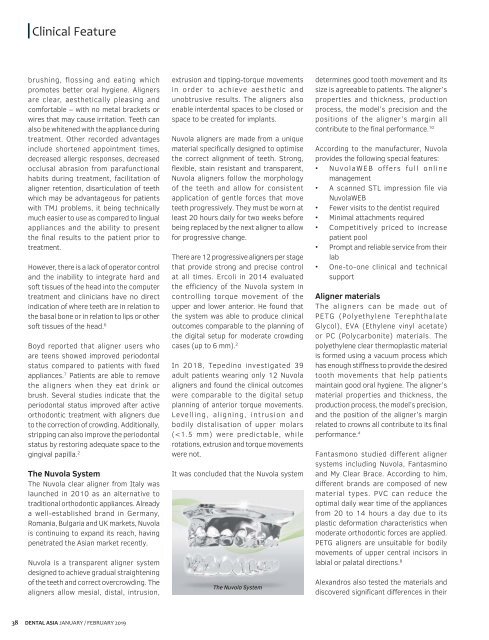Dental Asia January/February 2019
For more than two decades, Dental Asia is the premium journal in linking dental innovators and manufacturers to its rightful audience. We devote ourselves in showcasing the latest dental technology and share evidence-based clinical philosophies to serve as an educational platform to dental professionals. Our combined portfolio of print and digital media also allows us to reach a wider market and secure our position as the leading dental media in the Asia Pacific region while facilitating global interactions among our readers.
For more than two decades, Dental Asia is the premium journal in linking dental innovators
and manufacturers to its rightful audience. We devote ourselves in showcasing the latest dental technology and share evidence-based clinical philosophies to serve as an educational platform to dental professionals. Our combined portfolio of print and digital media also allows us to reach a wider market and secure our position as the leading dental media in the Asia Pacific region while facilitating global interactions among our readers.
You also want an ePaper? Increase the reach of your titles
YUMPU automatically turns print PDFs into web optimized ePapers that Google loves.
Clinical Feature<br />
brushing, flossing and eating which<br />
promotes better oral hygiene. Aligners<br />
are clear, aesthetically pleasing and<br />
comfortable – with no metal brackets or<br />
wires that may cause irritation. Teeth can<br />
also be whitened with the appliance during<br />
treatment. Other recorded advantages<br />
include shortened appointment times,<br />
decreased allergic responses, decreased<br />
occlusal abrasion from parafunctional<br />
habits during treatment, facilitation of<br />
aligner retention, disarticulation of teeth<br />
which may be advantageous for patients<br />
with TMJ problems, it being technically<br />
much easier to use as compared to lingual<br />
appliances and the ability to present<br />
the final results to the patient prior to<br />
treatment.<br />
However, there is a lack of operator control<br />
and the inability to integrate hard and<br />
soft tissues of the head into the computer<br />
treatment and clinicians have no direct<br />
indication of where teeth are in relation to<br />
the basal bone or in relation to lips or other<br />
soft tissues of the head. 6<br />
Boyd reported that aligner users who<br />
are teens showed improved periodontal<br />
status compared to patients with fixed<br />
appliances. 7 Patients are able to remove<br />
the aligners when they eat drink or<br />
brush. Several studies indicate that the<br />
periodontal status improved after active<br />
orthodontic treatment with aligners due<br />
to the correction of crowding. Additionally,<br />
stripping can also improve the periodontal<br />
status by restoring adequate space to the<br />
gingival papilla. 2<br />
The Nuvola System<br />
The Nuvola clear aligner from Italy was<br />
launched in 2010 as an alternative to<br />
traditional orthodontic appliances. Already<br />
a well-established brand in Germany,<br />
Romania, Bulgaria and UK markets, Nuvola<br />
is continuing to expand its reach, having<br />
penetrated the <strong>Asia</strong>n market recently.<br />
Nuvola is a transparent aligner system<br />
designed to achieve gradual straightening<br />
of the teeth and correct overcrowding. The<br />
aligners allow mesial, distal, intrusion,<br />
extrusion and tipping-torque movements<br />
in order to achieve aesthetic and<br />
unobtrusive results. The aligners also<br />
enable interdental spaces to be closed or<br />
space to be created for implants.<br />
Nuvola aligners are made from a unique<br />
material specifically designed to optimise<br />
the correct alignment of teeth. Strong,<br />
flexible, stain resistant and transparent,<br />
Nuvola aligners follow the morphology<br />
of the teeth and allow for consistent<br />
application of gentle forces that move<br />
teeth progressively. They must be worn at<br />
least 20 hours daily for two weeks before<br />
being replaced by the next aligner to allow<br />
for progressive change.<br />
There are 12 progressive aligners per stage<br />
that provide strong and precise control<br />
at all times. Ercoli in 2014 evaluated<br />
the efficiency of the Nuvola system in<br />
controlling torque movement of the<br />
upper and lower anterior. He found that<br />
the system was able to produce clinical<br />
outcomes comparable to the planning of<br />
the digital setup for moderate crowding<br />
cases (up to 6 mm). 2<br />
In 2018, Tepedino investigated 39<br />
adult patients wearing only 12 Nuvola<br />
aligners and found the clinical outcomes<br />
were comparable to the digital setup<br />
planning of anterior torque movements.<br />
Levelling, aligning, intrusion and<br />
bodily distalisation of upper molars<br />
(


















